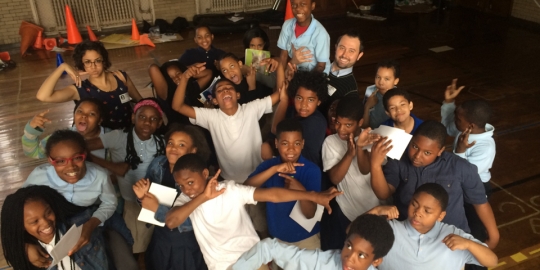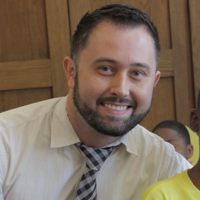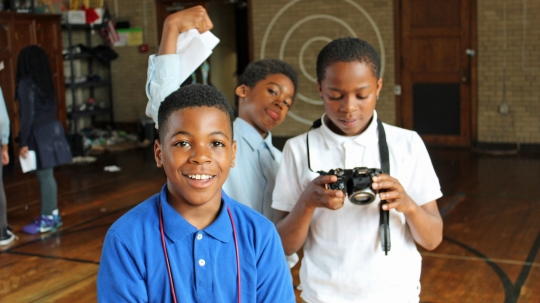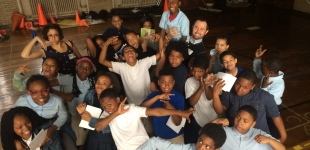
Jones Soda Co. and Young Audiences Arts for Learning (YA) began their partnership in early 2014 with the Launch of the Jones Soda Photography Program. This partnership highlights the emphasis that both organizations place on the importance of the arts and arts education to our students. From the start, Jones Soda established the importance of the arts to both its corporate culture and visual identity, incorporating photographer/designer Victor John Penner’s photography into their original product design and now encouraging Jones Soda lovers everywhere to submit photos to be featured on Jones Soda bottles.
The first Jones Soda Photography Program took place at the Urban Promise Academy in Oakland, California and featured a curriculum that involved basic photographic techniques and theory in relation to the specific discipline of digital photography. For this significant cause, Jones Soda enlisted its original photographer and designer Victor John Penner to help teach the course and mentor students. Since the original residency, the program has also been offered in Cleveland, Ohio; and Detroit, Michigan.
The Center for Arts-inspired Learning (CAL) Resident Teaching Artist Ryan Upp was responsible for leading the latest Jones Soda Photography Program at Oliver H. Perry Elementary School in Cleveland, OH. Throughout the ten-week residency, Ryan led thirty 5th grade students in ten photography workshops designed to introduce students to basic digital camera functions; alternative photographic processes like applying artistic concepts through the use of digital editing software; deepen their understanding of the history of photography; and professionally present their work to the school and the community. Young Audiences talked to Ryan about his artistic journey as well as his experience with the Jones Soda Photography Program. Read about it below!

Ryan received a Bachelor of Liberal Arts in Photography from Cleveland State University. His work has been acquired in private collections, published in The New York Times, and included in the exhibition, DIY: Photographers & Books, at the Cleveland Museum of Art. He currently is a resident teaching artist at the Center for Arts-Inspired Learning in Cleveland, Ohio.
Young Audiences: How did you first get started with photography? Did you have any photographers or teachers that inspired you?
Ryan Upp: I purchased my first camera, a Canon Elan, during my Junior year of high school and originally was self-taught. Several years later, I switched from film to digital and got my Bachelors degree in photography from Cleveland State University. I have always been most inspired by photographs of nature and the human subject. Some photographers who have influenced my work are Gregory Colbert, Kristy Mitchell, and Sally Mann. I am most drawn to photographers who capture a timelessness and ethereal quality in their work.
YA: Why do you believe it’s important for students to learn about photography?
Upp: It is important for students to learn about photography because their life is constantly bombarded with images. Understanding how an image is captured, edited, and presented changes how a student perceives the world around them. I’m an advocate of capturing “beautiful” shots, but I often remind students that beauty is subjective and that the images they see in advertisements and pop culture are heavily manipulated, photoshopped, and inaccurate representations of reality. The age group I work with is very impressionable so it’s important to reassure them that they are just as beautiful as the model in the magazine.
YA: How do you think the skills students learn in photography can translate to other disciplines both in and outside the arts?

Upp: All art forms, photography included, can translate and improve other disciplines. The elements that make a successful painting and photograph are the same: good lighting, rule of thirds, contrast/saturation, and interesting subject matter. I always approach the beginning of a photography residency with strong themes of history and science. My students are shown the early photographic work of Anna Atkins, who created botanical cyanotypes and is credited for publishing the first book of photography. The students then get to make their own solar print, which is engaging and hands-on and introduces them to the basic functions of a dark room.
YA: What was your favorite memory from the Jones Soda Residency?
Upp: Easy. Announcing the winner. I got teary eyed both times. Prior to the residency, a majority of the students had never even held a professional camera before. Seeing the quality of their work improve and the excitement they’d express immediately after catching that ‘perfect shot’ was personally inspiring. I loved how proud they were to take their finished prints home to share with their classmates and family.
YA: If you could give one piece of advice to a student looking to pursue photography as a career, what would it be?
Upp: Start building your portfolio early. Photography is what you make of it and can easily be learned without an instructor. There are free online resources available for early-career photographers, such as pinterest, behance, and flickr. I suggest that students start browsing other photography that appeals to them. Then start deciding on a personal aesthetic and style. Photography can get expensive so I urge students to take advantage of free web-based editing software, such as Picmonkey and Pixlr.


